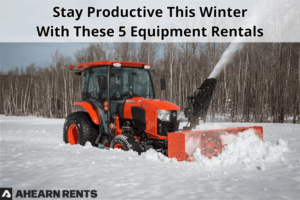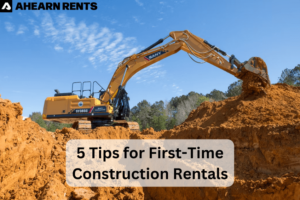Renting heavy-duty equipment can be a game-changer for construction projects, offering flexibility and access to top-of-the-line machinery without the commitment of a purchase. However, the process doesn’t end when the job does; properly returning the equipment is crucial to avoid unnecessary fees and maintain a positive relationship with your rental provider.
Whether it’s an excavator, a bulldozer, or any other type of heavy machinery, understanding the correct return procedures can save you time and money. This guide will walk you through the essential steps to ensure that your heavy rental equipment is returned in the best possible condition, adhering to the terms set out by your heavy equipment rental company.
Let’s dive into the best practices for a hassle-free return that safeguards both your interests and those of the rental company.
Understanding Rental Agreements
Before you even begin operating the rented heavy equipment, it’s crucial to have a clear understanding of the rental agreement. These contracts can vary significantly from one heavy equipment rental company to another, but they generally outline specific terms that cover the duration, fees, and conditions of the rental. Here are key aspects of rental agreements that you should pay careful attention to:
1) Rental Period
The agreement specifies the start and end dates of the rental period. It’s important to know these dates as returning the equipment late can incur additional charges. Conversely, returning equipment early might change the total rental cost, depending on the company’s policy.
2) Fees and Penalties
Be aware of all potential fees, including late returns, damage, and excessive wear and tear. Understanding these can help you avoid unexpected expenses when returning the equipment.
3) Equipment Condition
The agreement should clearly state the expected condition of the equipment upon return. Some agreements may allow for normal wear and tear, while others might require the equipment to be returned in a condition similar to when it was rented out.
4) Usage Restrictions
Some rental agreements specify where and how the equipment can be used. Restrictions might include geographic restrictions or prohibitions against certain types of physical environments that could pose increased risks to the equipment.
5) Insurance and Liability
Know who is responsible for insuring the equipment during the rental period. The agreement often outlines what happens in case of theft or damage and whether any additional insurance coverage is necessary.
Pre-Return Inspection Checklist
Before returning your heavy-duty rental equipment, conducting a thorough inspection is essential to ensure you meet the conditions stated in the rental agreement and avoid any potential penalties. Here’s a comprehensive checklist to guide you through inspecting the equipment:
1) Clean the Equipment
Remove any mud, debris, or material buildup. Cleaning not only helps you inspect the equipment more thoroughly but also typically forms part of the rental agreement terms.
2) Check for Damage
Look for any new damage that may have occurred during the rental period. Compare the condition of the equipment against the condition report you received at the start of the rental period. Document any discrepancies with photos and notes.
3) Review Fluid Levels
Ensure that all fluid levels (oil, hydraulic fluid, coolant, etc.) are at the recommended levels as per the manufacturer’s guidelines. Replenish any fluids if necessary to avoid penalties for maintenance neglect.
4) Inspect Wear and Tear
Check for signs of excessive wear and tear on critical components like bucket teeth, blades, tracks, or tires. Normal wear is expected, but significant damage or wear might incur additional charges.
5) Test Operational Functions
Operate the equipment to ensure all functions are working correctly. This testing includes hydraulics, engine operation, steering, and any electronic systems.
6) Document Everything
Take detailed notes and photographs of the equipment’s condition. This documentation can be crucial if there are any disputes upon return about the condition of the equipment.
7) Gather All Accessories and Documents
Make sure that any accessories, manuals, or other items that were rented with the equipment are returned together. Missing accessories or documentation can lead to extra charges.
LOOKING FOR HIGH-QUALITY REMANUFACTURED PARTS?
Cleaning and Maintenance Before Return
Ensuring that your heavy-duty rental equipment is clean and well-maintained before its return is not just about fulfilling a contractual obligation; it also reflects on your company’s professionalism and can influence future rental agreements. Here are the steps you should take to prepare your equipment for return properly:
1) Thorough Cleaning
Start with a thorough cleaning of the equipment. Use pressure washers, degreasers, or other cleaning tools appropriate for the type of machinery. Pay special attention to removing dirt and debris from hard-to-reach areas such as undercarriages, behind the cab, and around the engine compartment.
2) Maintenance Check
Conduct a basic maintenance check for the following:
- Lubrication: Ensure all moving parts are well-lubricated according to the equipment’s maintenance manual.
- Tightening Loose Bolts: Check for and tighten any loose bolts or fastenings that could have become loose during operation.
- Check and Fill Fluids: Make sure that all fluids are at the proper level and topped up if necessary. This check-in includes engine oil, hydraulic fluid, coolant, and fuel.
3) Wear and Tear Evaluation
Assess and note any wear and tear that goes beyond normal usage. This evaluation can include deep scratches, dents, or any mechanical issues that arose during the rental period. Documenting these can help in discussing any repair needs with the rental company.
4) Functionality Test
After cleaning and maintenance, run the equipment to ensure that it operates as expected. Check that all mechanical, hydraulic, and electronic functions are in working order. This step is your last chance to catch any operational issues before return.
5) Record Keeping
Keep a detailed record of the maintenance and cleaning processes you have undertaken, including dates, the scope of work, and any parts replaced. This documentation will be useful in case of disputes or claims from the rental company.
Transporting Equipment Back to the Rental Company
Returning heavy-duty rental equipment involves significant logistical planning, especially when dealing with large machinery. Properly transporting equipment not only ensures that it arrives back at the rental company in good condition but also helps to avoid additional fees or damage charges. Here are essential steps to follow when preparing for and executing the transport of heavy rental equipment:
1) Choose the Right Transport Method
Depending on the size and type of equipment, you may need specialized transport services. For smaller items, a standard trailer might suffice, but larger or heavier equipment will likely require low-loaders or other heavy-duty trailers equipped to handle significant weight and dimensions.
2) Check for Transport Compliance
Ensure that the transport method complies with all local regulations regarding weight, height, and securement of heavy machinery. Non-compliance can lead to fines, delays, and potential damage to the equipment.
3) Secure the Equipment Properly
Use chains, straps, and locks to secure the equipment to the transport vehicle. This precaution prevents movement during transit that could cause damage to the machinery. Pay special attention to parts that are particularly susceptible to damage, such as control levers, external lights, and mirrors.
4) Protect Sensitive Components
Depending on the equipment type, it might be necessary to take extra precautions like draining fluids or disconnecting batteries. Cover sensitive parts with protective materials to shield them from environmental elements during transport.
5) Plan Your Route
Map out a route that accommodates the size and weight of the transport vehicle and avoids roads with weight limits or low clearance that could pose challenges. Also, consider traffic patterns to minimize transit time and the risk of accidents.
6) Inspect Before Departure
Conduct a thorough inspection of the equipment once it’s loaded onto the transport vehicle. Double-check that everything is securely fastened and that the equipment is stable. Take photos for records.
7) Communicate with the Rental Company
Inform the rental company of the expected arrival time of the equipment. Good communication helps to ensure that there are personnel ready to receive and inspect the equipment, facilitating a smoother return process.
RENT THE TOP EXCAVATION AND CONSTRUCTION BRANDS TODAY
Final Check-In Process
Returning your heavy-duty rental equipment involves more than just transporting it back to the rental company; it requires a detailed check-in process to ensure everything is in order. This process is crucial for verifying the condition of the equipment and ensuring that any potential issues are addressed immediately. Here are the key steps involved in the final check-in process:
1) Initial Inspection Upon Arrival
When the equipment arrives back at the rental company, it should undergo an initial inspection. This inspection is usually conducted by a representative from the rental company, often with the customer present. This inspection should compare the current state of the equipment against its condition at the time of rental, using the initial inspection sheet as a reference.
2) Report and Document Any Discrepancies
If there are any discrepancies between the equipment’s current condition and the condition noted at the start of the rental, these should be documented in detail. Photographs should be taken to provide visual evidence of any new damage or wear.
3) Review Usage Logs and Maintenance Records
Present any logs or records that detail the usage and maintenance of the equipment during the rental period. This review includes hours of operation, fuel usage, and any repairs or maintenance that were performed. These logs help the rental company understand how the equipment was used and can influence final charges or deposits.
4) Settle Additional Fees or Damages
If there are any additional fees for extended use, damages, or extra cleaning required, these should be settled during the final check-in. Ensure that all charges are explained and justified based on the terms outlined in the rental agreement.
5) Receive a Return Receipt
Once everything is checked and all fees are settled, ensure you receive a return receipt that confirms the equipment has been returned and lists any charges or damages noted during the check-in. This receipt is your proof of return and should be kept for your records.
6) Feedback and Future Rentals
Before leaving, provide feedback on your rental experience. This feedback is also a good time to discuss any future rental needs or to reserve equipment for upcoming projects. Building a relationship with your rental company can lead to better service and potentially advantageous terms in the future.
Key Takeaways
- Understand Your Rental Agreement: Familiarize yourself with all terms and conditions to avoid surprises.
- Conduct a Thorough Pre-Return Inspection: This helps identify any potential issues that can be addressed before returning the equipment.
- Clean and Maintain the Equipment: Returning equipment in clean and well-maintained condition can help avoid extra charges.
- Keep Detailed Records: Documentation of maintenance and any repairs conducted during the rental period is crucial.
- Follow Proper Procedures for Documentation and Check-In: Ensure all paperwork is in order, and participate in the final check-in process to confirm the state of the equipment.
- Plan for Transportation: Arrange for safe and timely transportation of the equipment back to the rental company.
Ready to ensure your next equipment rental experience is hassle-free and cost-effective? At Ahearn Rents, we’re here to help you find the right heavy-duty equipment for your projects. Our expert team is committed to providing top-quality service and support. Contact us today to learn more about our rental options or to discuss your next project. Let’s get to work and make your next equipment rental a success!
FIND THE BEST CONSTRUCTION EQUIPMENT AT AHEARN RENTS!
About Ahearn Rents
At Ahearn Equipment, we’ve got you covered. With over 40 years of experience, we’re your destination for heavy winter equipment rentals. Follow us on LinkedIn for exclusive promotions and updates in the heavy equipment industry. So, when it comes to your next project, remember to partner with us for a smooth and reliable rental experience. We’re here to support you every step of the way. Let’s get to work!



